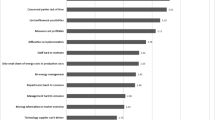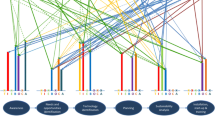Abstract
The previous literature has studied barriers to energy efficiency in firms. While there are several studies with some focus on the manufacturing sector in Europe, the corresponding literature in Asia is still nascent. Using a unique dataset that contains a large number of firms belonging to the service and manufacturing sectors in Japan, this study contributes to filling this gap in the literature. The uniqueness of the data set allows us to distinguish small firms from both medium-sized and large firms. We evaluated the implementation of environmental practices, focusing on barriers to energy efficiency, and found that in the implementation of energy-conserving practices, small firms lag far behind large firms. We also found positive impacts from staff assignment on this goal. By contrast, firms were less likely to implement these practices if senior executives were in charge of energy efficiency issues. The data analysis further revealed that a limited number of SMEs and of service sector firms assign dedicated staff to achieve energy efficiency. The estimation results suggest that a policy measure may stimulate the development of economically feasible energy-conserving practices within SMEs if it encourages them to develop their organisational capacity to assign staff dedicated to promoting energy efficiency.








Similar content being viewed by others
Notes
Firms in this study were categorised according to the basic law regulating small businesses in Japan. Firms with over 300 employees in the manufacturing and other industries, those with over 100 employees in the wholesale and service industries and those over 50 employees in the retail industry were categorised as large. Firms with fewer than 5 employees in the commercial and service industries or fewer than 20 employees in the manufacturing and other industries were considered small. Last, firms that were smaller than large firms but larger than small firms, as defined above, were considered medium-sized firms.
References
Anderson, S. T., & Newell, R. G. (2004). Information programs for technology adoption: The case of energy-efficiency audits. Resource and Energy Economics, 26, 27–50. https://doi.org/10.1016/j.reseneeco.2003.07.001.
Arimura, T. H., Darnall, N., & Katayama, H. (2011). Is ISO 14001 a gateway to more advanced voluntary action? The case of green supply chain management. Journal of Environmental Economics and Management, 61(2), 170–182. https://doi.org/10.1016/j.jeem.2010.11.003.
Arimura, T. H., Katayama, H., & Sakudo, M. (2016). Do social norms matter to energy-saving behavior? Endogenous social and correlated effects. Journal of the Association of Environmental and Resource Economists, 3(3), 525–553.
Bloom, N., et al. (2012). Does management matter? Evidence from India. The Quarterly Journal of Economics, 128(1), 1–51.
Cagno, E., & Trianni, A. (2014). Evaluating the barriers to specific industrial energy efficiency measures: An exploratory study in small and medium-sized enterprises. Journal of Cleaner Production, 82, 70–83. https://doi.org/10.1016/j.jclepro.2014.06.057.
Gerarden, T. D., Newell, R. G., & Stavins, R. N. (2015). Assessing the energy-efficiency gap. Cambridge: Harvard Environmental Economics Program.
Fleiter, T., Schleich, J., & Ravivanpong, P. (2012). Adoption of energy-efficiency measures in SMEs—An empirical analysis based on energy audit data from Germany. Energy Policy, 51, 863–875.
Gillingham, K., & Palmer, K. (2014). Bridging the energy efficiency gap policy insights from economic theory and empirical evidence. Review of Environmental Economics and Policy, 8(1), 18–38.
Gruber, E., & Brand, M. (1991). Promoting energy conservation in small and medium-sized companies. Energy Policy, 19(3), 279–287.
IEA (2015). Policy pathway - accelerating energy efficiency in small and medium-sized enterprises 2015. OECD/IEA. p 81. Available online at: https://webstore.iea.org/policy-pathway-accelerating-energyefficiency-in-small-and-medium-sized-enterprises-2015. Accessed 5 Aug 2020.
IEA (2017). Market Report Series: Energy Efficiency 2017. OECD/IEA. pp. 143.
Jaffe, A. B., & Stavins, R. N. (1994). The energy-efficiency gap: What does it mean? Energy Policy, 22(10), 804–810.
JCCI, & METI (2017). Survey result on environmental practices for energy efficiency implemented in SMEs. https://www.jcci.or.jp/sangyo2/20170317_jcci_meti_globalwarming2.pdf (in Japanese). Accessed 5 Aug 2020.
Liu, X., Yamamoto, R., & Suk, S. (2014). A survey analysis of energy saving activities of industrial companies in Hyogo, Japan. Journal of Cleaner Production, 66, 288–300. https://doi.org/10.1016/j.jclepro.2013.10.011.
Martin, R., Muûls, M., de Preux, L. B., & Wagner, U. J. (2012). Anatomy of a paradox: Management practices, organizational structure and energy efficiency. Journal of Environmental Economics and Management, 63(2), 208–223. https://doi.org/10.1016/j.jeem.2011.08.003.
Meath, C., Linnenluecke, M., & Griffiths, A. (2016). Barriers and motivators to the adoption of energy savings measures for small- and medium-sized enterprises (SMEs): The case of the climate smart business cluster program. Journal of Cleaner Production, 112, 3597–3604.
Olsthoorn, M., Schleich, J., & Hirzel, S. (2017). Adoption of energy efficiency measures for non-residential buildings: Technological and organizational heterogeneity in the trade, commerce and services sector. Ecological Economics, 136, 240–254. https://doi.org/10.1016/j.ecolecon.2017.02.022.
Rohdin, P., & Thollander, P. (2006). Barriers to and driving forces for energy efficiency in the non-energy intensive manufacturing industry in Sweden. Energy, 31(12), 1836–1844. https://doi.org/10.1016/j.energy.2005.10.010.
Schleich, J. (2004). Do energy audits help reduce barriers to energy efficiency? An empirical analysis for Germany. International Journal of Energy Technology and Policy, 2(3), 226–239.
Schleich, J., & Fleiter, T. (2019). Effectiveness of energy audits in small business organizations. Resource and Energy Economics, 56, 59–70.
Schleich, J., & Gruber, E. (2008). Beyond case studies: Barriers to energy efficiency in commerce and the services sector. Energy Economics, 30(2), 449–464.
Schlomann, B., & Schleich, J. (2015). Adoption of low-cost energy efficiency measures in the tertiary sector—An empirical analysis based on energy survey data. Renewable and Sustainable Energy Reviews, 43, 1127–1133. https://doi.org/10.1016/j.rser.2014.11.089.
Sorrell, S., Mallett, A., & Nye, S. (2011). Barriers to industrial energy efficiency: A literature review. Vienna: University of Sussex.
Thollander, P., Danestig, M., & Rohdin, P. (2007). Energy policies for increased industrial energy efficiency: Evaluation of a local energy programme for manufacturing SMEs. Energy Policy, 35(11), 5774–5783. https://doi.org/10.1016/j.enpol.2007.06.013.
Thollander, P., & Ottosson, M. (2008). An energy efficient Swedish pulp and paper industry – Exploring barriers to and driving forces for cost-effective energy efficiency investments. Energy Efficiency, 1, 21–34. https://doi.org/10.1007/s12053-007-9001-7.
Thollander, P., & Palm, J. (2013). Improving energy efficiency in industrial energy systems. An interdisciplinary perspective on barriers, energy audits, energy management, policies, and programs (Green Energy and Technology). Springer. https://doi.org/10.1007/978-1-4471-4162-4.
Trianni, A., Cagno, E., & Farné, S. (2016). Barriers, drivers and decision-making process for industrial energy efficiency: A broad study among manufacturing small and medium-sized enterprises. Applied Energy, 162, 1537–1551. https://doi.org/10.1016/j.apenergy.2015.02.078.
Tushman, M. L. (1977). Special boundary roles in the innovation process. Administrative Science Quarterly, 22(4), 587–605. https://doi.org/10.2307/2392402.
Wakabayashi, M., & Arimura, T. H. (2016). Voluntary agreements to encourage proactive firm action against climate change: An empirical study of industry associations' voluntary action plans in Japan. Journal of Cleaner Production, 112, 2885–2895. https://doi.org/10.1016/j.jclepro.2015.10.071.
Wakabayashi, M., & Kimura, O. (2018). The impact of the Tokyo metropolitan emissions trading scheme on reducing greenhouse gas emissions: Findings from a facility-based study. Climate Policy, 1-16, https://doi.org/10.1080/14693062.2018.1437018.
Funding
This work was supported by the Japan Science and Technology Agency, CREST Grant Number JPMJCR15K2.
Author information
Authors and Affiliations
Corresponding author
Ethics declarations
Conflict of interest
The authors declare that they have no conflict of interest.
Additional information
Publisher’s note
Springer Nature remains neutral with regard to jurisdictional claims in published maps and institutional affiliations.
Electronic supplementary material
ESM 1
(DOCX 23 kb).
Rights and permissions
About this article
Cite this article
Wakabayashi, M., Arimura, T.H. The role of staff assignment in implementing energy-conserving practices in small- and medium-sized firms: an empirical analysis based on data from a Japanese survey. Energy Efficiency 13, 1763–1780 (2020). https://doi.org/10.1007/s12053-020-09904-1
Received:
Accepted:
Published:
Issue Date:
DOI: https://doi.org/10.1007/s12053-020-09904-1




